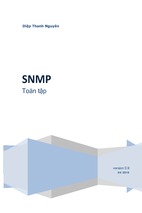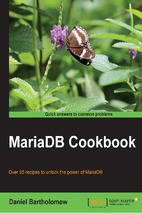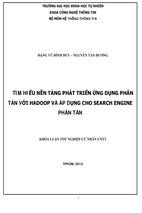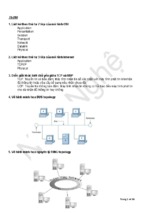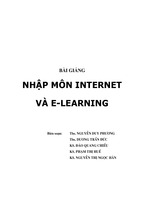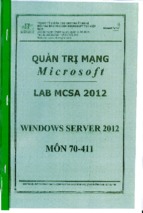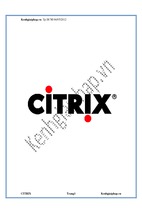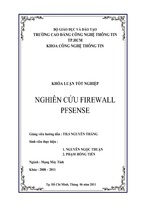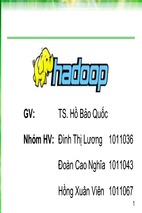Ubuntu OpenStack Architecture on
Cisco UCS Platform
Last Updated: June 25, 2014
Building Architectures to Solve Business Problems
2
Cisco Validated Design
About the Authors
About the Authors
Mehul Bhatt, Virtualization Architect, Server Access Virtualization Business Unit
(SAV BU), Cisco Systems
Mehul Bhatt
3
Mehul Bhatt has over 12 years of experience in virtually all layers of computer networking.
His focus area includes Unified Compute Systems, network and server virtualization
design. Prior to joining Cisco Technical Marketing team, Mehul was Technical Lead at
Cisco, Nuova systems and Bluecoat systems. Mehul holds a Master’s degree in computer
systems engineering and holds various Cisco career certifications.
Acknowledgment
For the support and contribution to the design, validation, and creation of this Cisco Validated Design,
I would like to thank:
•
Rakhee Gorthi - Cisco
•
Gopi Krishna S - Cisco
•
Robert Stammer - Cisco
•
Samantha Jiyan - Canonical
•
Ashok Rajgopalan - Cisco
•
Mike Andren - Cisco
•
Chris Ricker - Cisco
•
Mark Voelker - Cisco
•
Sindhu Sudhir - Cisco
•
Sankar Jayaram - Cisco
About Cisco Validated Design (CVD) Program
The CVD program consists of systems and solutions designed, tested, and documented to facilitate faster, more reliable,
and more predictable customer deployments. For more information visit:
http://www.cisco.com/go/designzone
ALL DESIGNS, SPECIFICATIONS, STATEMENTS, INFORMATION, AND RECOMMENDATIONS (COLLECTIVELY, "DESIGNS") IN THIS MANUAL ARE PRESENTED "AS IS," WITH ALL FAULTS. CISCO AND ITS
SUPPLIERS DISCLAIM ALL WARRANTIES, INCLUDING, WITHOUT LIMITATION, THE WARRANTY OF
MERCHANTABILITY, FITNESS FOR A PARTICULAR PURPOSE AND NONINFRINGEMENT OR ARISING
FROM A COURSE OF DEALING, USAGE, OR TRADE PRACTICE. IN NO EVENT SHALL CISCO OR ITS SUPPLIERS BE LIABLE FOR ANY INDIRECT, SPECIAL, CONSEQUENTIAL, OR INCIDENTAL DAMAGES,
INCLUDING, WITHOUT LIMITATION, LOST PROFITS OR LOSS OR DAMAGE TO DATA ARISING OUT OF
THE USE OR INABILITY TO USE THE DESIGNS, EVEN IF CISCO OR ITS SUPPLIERS HAVE BEEN ADVISED
OF THE POSSIBILITY OF SUCH DAMAGES.
THE DESIGNS ARE SUBJECT TO CHANGE WITHOUT NOTICE. USERS ARE SOLELY RESPONSIBLE FOR
THEIR APPLICATION OF THE DESIGNS. THE DESIGNS DO NOT CONSTITUTE THE TECHNICAL OR
OTHER PROFESSIONAL ADVICE OF CISCO, ITS SUPPLIERS OR PARTNERS. USERS SHOULD CONSULT
THEIR OWN TECHNICAL ADVISORS BEFORE IMPLEMENTING THE DESIGNS. RESULTS MAY VARY
DEPENDING ON FACTORS NOT TESTED BY CISCO.
The Cisco implementation of TCP header compression is an adaptation of a program developed by the University of
California, Berkeley (UCB) as part of UCB’s public domain version of the UNIX operating system. All rights reserved.
Copyright © 1981, Regents of the University of California.
Cisco and the Cisco Logo are trademarks of Cisco Systems, Inc. and/or its affiliates in the U.S. and other countries. A
listing of Cisco's trademarks can be found at http://www.cisco.com/go/trademarks. Third party trademarks mentioned
are the property of their respective owners. The use of the word partner does not imply a partnership relationship
between Cisco and any other company. (1005R)
Any Internet Protocol (IP) addresses and phone numbers used in this document are not intended to be actual addresses
and phone numbers. Any examples, command display output, network topology diagrams, and other figures included in
the document are shown for illustrative purposes only. Any use of actual IP addresses or phone numbers in illustrative
content is unintentional and coincidental.
© 2014 Cisco Systems, Inc. All rights reserved.
Ubuntu OpenStack Architecture on Cisco
UCS Platform
Executive Summary
OpenStack is a free and open source Infrastructure-as-a-Service (IaaS) cloud computing project released
under the Apache License. It enables enterprises and service providers to offer on-demand computing
resources by provisioning and managing large networks of virtual machines. Canonical OpenStack
technology on Ubuntu coupled with Ink Tank Ceph storage architecture uses upstream OpenStack open
source architecture and enhances it for Enterprise and service provider customers with better support
structure. The Cisco Unified Computing System is a next-generation data center platform that unites
computing, network, storage access, and virtualization into a single cohesive system. Cisco UCS is an
ideal platform for the OpenStack architecture. The combination of Cisco UCS and Canonical OpenStack
Platform accelerates your IT Transformation by enabling faster deployments, greater flexibility of
choice, efficiency, and lower risk. This Cisco Validate Design document focuses on deploying Canonical
OpenStack Platform architecture on Cisco UCS with Ceph storage for enterprise and service provider
business segments.
Introduction
OpenStack boasts a massively scalable architecture that can control compute, storage, and networking
resources through a unified interface. The OpenStack development community operates on a six-month
release cycle with frequent milestones. Their code base is composed of many loosely coupled projects
supporting storage, compute, image management, identity, and networking services. OpenStack’s rapid
development cycle and architectural complexity create unique challenges for enterprise customers
adding OpenStack to their traditional IT portfolios.
Canonical OpenStack technology addresses these challenges. This CVD focuses on Canonical Havana
based OpenStack modules running on Ubuntu 12.04 LTS release. Adopters of Canonical OpenStack
architecture on Ubuntu enjoy immediate access to bug fixes and critical security patches, tight
integration with Ubuntu 12.04 LTS enterprise security features, and a steady release cadence between
OpenStack versions. This allows Canonical customers to adopt OpenStack with confidence, at their own
pace, and on their own terms.
Corporate Headquarters:
Cisco Systems, Inc., 170 West Tasman Drive, San Jose, CA 95134-1706 USA
Copyright © 2014 Cisco Systems, Inc. All rights reserved.
Solution Overview
Virtualization is a key and critical strategic deployment model for reducing the Total Cost of Ownership
(TCO) and achieving better utilization of the platform components like hardware, software, network and
storage. However choosing the appropriate platform for virtualization can be a tricky task. The platform
should be flexible, reliable and cost effective to facilitate the deployment of various enterprise
applications onto the virtualization layer. Also, the ability to slice and dice the underlying platform to
match the application requirements is essential for a virtualization platform to utilize compute, network
and storage resources efficiently. In this regard, implementing OpenStack on Cisco UCS provides a very
simplistic yet fully integrated and validated infrastructure for you to deploy VMs in various sizes to suite
your application needs.
Target Audience
The reader of this document is expected to have the necessary training and background to install and
configure Ubuntu Linux and Cisco Unified Computing System (UCS) and Unified Computing Systems
Manager (UCS Manager) as well as a high-level understanding of OpenStack components. External
references are provided where applicable and it is recommended that the reader be familiar with these
documents.
Readers are also expected to be familiar with the infrastructure and network and security policies of the
customer installation.
Purpose of this Document
This document describes the steps required to deploy and configure Canonical OpenStack architecture
on the Cisco UCS platform to a level that will allow for confirmation that the basic components and
connections are working correctly. The document addresses small- to medium-sized deployments;
however the architecture can be very easily expanded with predictable linear performance. While readers
of this document are expected to have sufficient knowledge to install and configure the products used,
configuration details that are important to this solution deployment are specifically mentioned.
Solution Overview
Canonical OpenStack Architecture on Cisco UCS Platform
This solution provides an end-to-end architecture with Cisco, Canonical Ubuntu, and OpenStack
technologies including Ceph for storage that demonstrate high availability and server redundancy along
with ease of deployment and use.
The following are the components used for the design and deployment:
•
Cisco Unified Compute System (UCS) 2.2(1)
•
Cisco C-series Unified Computing System servers for compute and storage needs
•
Cisco UCS VIC adapters
•
Cisco Nexus 6000 series switches
•
Canonical Ubuntu 12.04 LTS
•
OpenStack Havana architecture
Ubuntu OpenStack Architecture on Cisco UCS Platform
7
Technology Overview
•
Ceph storage module supported by Ink Tank
The solution is designed to host scalable, mixed application workloads. The scope of this CVD is limited
to the infrastructure pieces of the solution; the CVD does not address the vast area of OpenStack
components and multiple configuration choices available there.
The CVD also show cases the Cisco OpenStack installer and UCS integration scripts for ease of
deployment.
Technology Overview
Cisco Unified Computing System
The Cisco Unified Computing System is a next-generation data center platform that unites computing,
network, storage access, and virtualization into a single cohesive system.
The main components of the Cisco UCS are:
•
Computing—The system is based on an entirely new class of computing system that incorporates
blade servers based on Intel Xeon E5-2600 V2 Series Processors.
•
Network—The system is integrated onto a low-latency, lossless, 10-Gbps unified network fabric.
This network foundation consolidates LANs, SANs, and high-performance computing networks
which are separate networks today. The unified fabric lowers costs by reducing the number of
network adapters, switches, and cables, and by decreasing the power and cooling requirements.
•
Virtualization—The system unleashes the full potential of virtualization by enhancing the
scalability, performance, and operational control of virtual environments. Cisco security, policy
enforcement, and diagnostic features are now extended into virtualized environments to better
support changing business and IT requirements.
•
Storage—Cisco C-series servers can host large number of local SATA hard disks. The system
provides consolidated access to both SAN storage and Network Attached Storage (NAS) over the
unified fabric. By unifying the storage access the Cisco Unified Computing System can access
storage over Ethernet, Fibre Channel, Fibre Channel over Ethernet (FCoE), and iSCSI. This
provides customers with choice for storage access and investment protection. In addition, the server
administrators can pre-assign storage-access policies for system connectivity to storage resources,
simplifying storage connectivity, and management for increased productivity.
The Cisco Unified Computing System is designed to deliver:
•
A reduced Total Cost of Ownership (TCO) and increased business agility.
•
Increased IT staff productivity through just-in-time provisioning and mobility support.
•
A cohesive, integrated system which unifies the
•
•
technology in the data center.
Industry standards supported by a partner ecosystem of industry leaders.
Ubuntu OpenStack Architecture on Cisco UCS Platform
8
Technology Overview
Cisco Nexus 6001 Switches
The Cisco Nexus 6001 Series Switch is a wire-rate Layer 2 and Layer 3, 48-port 10 Gigabit Ethernet
(GE) switch with 40 GE uplinks. It is optimized for high-performance, top-of-rack 10 GE server access
and Cisco Fabric Extender (FEX) aggregation. The switch delivers high performance, operational
efficiency, and design flexibility for traditional, virtualized, and cloud environments.
Cisco UCS Manager
Cisco Unified Computing System (UCS) Manager provides unified, embedded management of all
software and hardware components of the Cisco UCS through an intuitive GUI, a command line
interface (CLI), or an XML API. The Cisco UCS Manager provides unified management domain with
centralized management capabilities and controls multiple chassis and thousands of virtual machines.
Figure 1
Cisco Nexus 6001 Switch
Fabric Interconnect
These devices provide a single point for connectivity and management for the entire system. Typically
deployed as an active-active pair, the system’s fabric interconnects integrate all components into a
single, highly-available management domain controlled by Cisco UCS Manager. The fabric
interconnects manage all I/O efficiently and securely at a single point, resulting in deterministic I/O
latency regardless of a server or virtual machine’s topological location in the system.
Cisco UCS 6248UP Fabric Interconnect
Cisco UCS 6200 Series Fabric Interconnects support the system’s 10-Gbps unified fabric with
low-latency, lossless, cut-through switching that supports IP, storage, and management traffic using a
single set of cables. The fabric interconnects feature virtual interfaces that terminate both physical and
virtual connections equivalently, establishing a virtualization-aware environment in which blade, rack
servers, and virtual machines are interconnected using the same mechanisms. The Cisco UCS 6248UP
is a 1-RU Fabric Interconnect that features up to 48 universal ports that can support 10 Gigabit Ethernet,
Fibre Channel over Ethernet, or native Fibre Channel connectivity. The Cisco UCS 6296UP packs 96
universal ports into only two rack units.
Ubuntu OpenStack Architecture on Cisco UCS Platform
9
Technology Overview
Figure 2
Cisco UCS 6248UP Fabric Interconnect
Cisco UCS 2200 Series Fabric Extenders
The Cisco UCS 2200 Series Fabric Extenders multiplex and forward all traffic from blade servers in a
chassis to a parent Cisco UCS fabric interconnect over from 10-Gbps unified fabric links. All traffic,
even traffic between blades on the same chassis or virtual machines on the same blade, is forwarded to
the parent interconnect, where network profiles are managed efficiently and effectively by the fabric
interconnect. At the core of the Cisco UCS fabric extender are application-specific integrated circuit
(ASIC) processors developed by Cisco that multiplex all traffic.
Fabric Extender
Fabric Extenders are zero-management, low-cost, low-power consuming devices that distribute the
system’s connectivity and management planes into rack and blade chassis to scale the system without
complexity. Designed never to lose a packet, Cisco fabric extenders eliminate the need for top-of-rack
Ethernet and Fibre Channel switches and management modules, dramatically reducing infrastructure
cost per server.
Cisco UCS 2232PP Fabric Extender
The Cisco Nexus® 2000 Series Fabric Extenders comprise a category of data center products designed
to simplify data center access architecture and operations. The Cisco Nexus 2000 Series uses the Cisco®
Fabric Extender architecture to provide a highly scalable unified server-access platform across a range
of 100 Megabit Ethernet, Gigabit Ethernet, 10 Gigabit Ethernet, unified fabric, copper and fiber
connectivity, rack, and blade server environments. The platform is ideal to support today's traditional
Gigabit Ethernet while allowing transparent migration to 10 Gigabit Ethernet, virtual machine-aware
unified fabric technologies.
The Cisco Nexus 2000 Series Fabric Extenders behave as remote line cards for a parent Cisco Nexus
switch or Fabric Interconnect. The fabric extenders are essentially extensions of the parent Cisco UCS
Fabric Interconnect switch fabric, with the fabric extenders and the parent Cisco Nexus switch together
forming a distributed modular system. This architecture enables physical topologies with the flexibility
and benefits of both top-of-rack (ToR) and end-of-row (EoR) deployments.
Today's data centers must have massive scalability to manage the combination of an increasing number
of servers and a higher demand for bandwidth from each server. The Cisco Nexus 2000 Series increases
the scalability of the access layer to accommodate both sets of demands without increasing management
points within the network.
Ubuntu OpenStack Architecture on Cisco UCS Platform
10
Technology Overview
Figure 3
Cisco UCS 2232PP Fabric Extender
Cisco C220 M3 rack mount servers
Building on the success of the Cisco UCS C220 M2 Rack Servers, the enterprise-class Cisco UCS C220
M3 server further extends the capabilities of the Cisco Unified Computing System portfolio in a
1-rack-unit (1RU) form factor. And with the addition of the Intel® Xeon® processor E5-2600 product
family, it delivers significant performance and efficiency gains.
Figure 4
Cisco UCS C220 M3 Rack Mount Server
The Cisco UCS C220 M3 also offers up to 256 GB of RAM, eight drives or SSDs, and two 1GE LAN
interfaces built into the motherboard, delivering outstanding levels of density and performance in a
compact package.
Cisco C240 M3 rack mount servers
The UCS C240 M3 High Density Small Form Factory Disk Drive Model rack server is designed for both
performance and expandability over a wide range of storage-intensive infrastructure workloads from big
data to collaboration. The enterprise-class UCS C240 M3 server extends the capabilities of Cisco
Unified Computing System portfolio in a 2U form factor with the addition of the Intel® Xeon E5-2600
v2 and E5-2600 series processor family CPUs that deliver the best combination of performance,
flexibility and efficiency gains. In addition, the UCS C240 M3 server provides 24 DIMM slots, up to 24
drives and 4 x 1 GbE LOM ports to provide outstanding levels of internal memory and storage
expandability along with exceptional performance.
Figure 5
Cisco UCS C240 M3 Rack Mount Server
Cisco I/O Adapters
The Cisco UCS rack mount server has various Converged Network Adapters (CNA) options. The UCS
1225 Virtual Interface Card (VIC) option is used in this Cisco Validated Design.
Ubuntu OpenStack Architecture on Cisco UCS Platform
11
Technology Overview
A Cisco® innovation, the Cisco UCS Virtual Interface Card (VIC) 1225 (Figure 6) is a dual-port
Enhanced Small Form-Factor Pluggable (SFP+) 10 Gigabit Ethernet and Fibre Channel over Ethernet
(FCoE)-capable PCI Express (PCIe) card designed exclusively for Cisco UCS C-Series Rack Servers.
UCS 1225 VIC provides the capability to create multiple VNICs (up to 128) on the CNA. This allows
complete I/O configurations to be provisioned in virtualized or non-virtualized environments using
just-in-time provisioning, providing tremendous system flexibility and allowing consolidation of
multiple physical adapters.
System security and manageability is improved by providing visibility and portability of network
policies and security all the way to the virtual machines. Additional 1225 features like VM-FEX
technology and pass-through switching, minimize implementation overhead and complexity.
Figure 6
Cisco UCS 1225 VIC
UCS Single-Wire Management without Fabric Extenders
Starting from Cisco UCS Manager 2.1 supports an additional option to integrate the C-Series
Rack-Mount Server with Cisco UCS Manager called “single-wire management”. This option enables
Cisco UCS Manager to manage the C-Series Rack-Mount Servers using a single 10 GE link for both
management traffic and data traffic. When you use the single-wire management mode, one host facing
port on the FEX is sufficient to manage one rack-mount server, instead of the two ports you will use in
the Shared-LOM mode. Cisco VIC 1225, Cisco UCS 2232PP FEX and Single-Wire management feature
of UCS 2.1 tremendously increases the scale of C-series server manageability. By consuming as little as
one port on the UCS Fabric Interconnect, you can manage up to 32 C-series server using single-wire
management feature.
While single wire management feature of Cisco UCS Manager 2.1 provides excellent scalability by
managing up to 160 servers per UCS domain, the requirement of having a Fabric Extender between
C-series serves and the Fabric Interconnects can be viewed as an overhead for small scale deployments.
In case of UCS 5548UP Fabric Interconnects, you have 48 ports on fixed module. With maximum 8 x
10GE links between Fabric Interconnect and FEX, you can support up to 32 C-series servers per UCS
2232PP Fabric Extender, providing 4:1 over-subscription. With that configuration, you can scale out to
maximum 160 C-series servers with 5 Fabric Extenders per UCS domain, consuming 40 ports on Fabric
Interconnect. With maximum 32:1 over-subscription, the number of ports consumed on Fabric
Interconnect can be reduced to 5 ports with a single 10GE cable between Fabric Interconnect and FEX.
Ubuntu OpenStack Architecture on Cisco UCS Platform
12
Technology Overview
With UCS 2.2 release, single wire management of C-series servers can be achieved by directly
connecting server to Fabric Interconnect, without requiring a Fabric Extender in between. If your UCS
pod is not expected to grow beyond 40 C-series servers, then you can opt out the need for Fabric
Extender. This would reduce overhead of using Fabric Extenders, saving power, cables and rack space.
UCS Differentiators
Cisco Unified Compute System is revolutionizing the way servers are managed in data-center. Following
are the unique differentiators of UCS and UCS-Manager.
1.
Embedded management—In UCS, the servers are managed by the embedded firmware in the
Fabric Interconnects, eliminating need for any external physical or virtual devices to manage the
servers. Also, a pair of Fabric Interconnects can manage up to 20 chassis, each containing 8 blade
servers. This gives enormous scaling on management plane.
2.
Unified fabric—In UCS, from blade server chassis or rack server fabric-extender to Fabric
Interconnect, there is a single Ethernet cable used for LAN, SAN and management traffic. This
converged I/O results in reduced cables, SFPs and adapters – reducing capital and operational
expenses of overall solution.
3.
Auto Discovery—By simply inserting the blade server in the chassis or connecting rack server to
the fabric extender, discovery and inventory of compute resource occurs automatically without any
management intervention. Combination of unified fabric and auto-discovery enables wire-once
architecture of UCS, where compute capability of UCS can extending easily while keeping the
existing external connectivity to LAN, SAN and management networks.
4.
Policy based resource classification—Once a compute resource is discovered by Cisco UCS
Manager, it can be automatically classified to a given resource pool based on policies defined. This
capability is useful in multi-tenant cloud computing. This CVD show cases the policy based
resource classification of Cisco UCS Manager.
5.
Combined Rack and Blade server management—Cisco UCS Manager can manage B-series blade
servers and C-series rack server under the same UCS domain. This feature, along with stateless
computing makes compute resources truly hardware form factor agnostic. In this CVD, we are
show-casing combination of B and C series servers to demonstrate stateless and form factor
independent computing work load.
6.
Model based management architecture—Cisco UCS Manager architecture and management
database is model based and data driven. Open, standard based XML API is provided to operate on
the management model. This enables easy and scalable integration of Cisco UCS Manager with
other management system, such as VMware vCloud director, Microsoft system center, and Citrix
CloudPlatform.
7.
Policies, Pools, Templates—Management approach in Cisco UCS Manager is based on defining
policies, pools and templates, instead of cluttered configuration, which enables simple, loosely
coupled, data driven approach in managing compute, network and storage resources.
8.
Loose referential integrity—In Cisco UCS Manager, a service profile, port profile or policies can
refer to other policies or logical resources with loose referential integrity. A referred policy cannot
exist at the time of authoring the referring policy or a referred policy can be deleted even though
other policies are referring to it. This provides different subject matter experts to work
independently from each-other. This provides great flexibilities where different experts from
different domains, such as network, storage, security, server and virtualization work together to
accomplish a complex task.
Ubuntu OpenStack Architecture on Cisco UCS Platform
13
Technology Overview
9.
Policy resolution—In Cisco UCS Manager, a tree structure of organizational unit hierarchy can be
created that mimics the real life tenants and/or organization relationships. Various policies, pools
and templates can be defined at different levels of organization hierarchy. A policy referring to other
policy by name is resolved in the organization hierarchy with closest policy match. If no policy with
specific name is found in the hierarchy till root organization, then special policy named “default” is
searched. This policy resolution practice enables automation friendly management APIs and
provides great flexibilities to owners of different organizations.
10. Service profiles and stateless computing—Service profile is a logical representation of a server,
carrying its various identities and policies. This logical server can be assigned to any physical
compute resource as far as it meets the resource requirements. Stateless computing enables
procurement of a server within minutes, which used to take days in legacy server management
systems.
11. Built-in multi-tenancy support—Combination of policies, pools and templates, loose referential
integrity, policy resolution in organization hierarchy and service profile based approach to compute
resources makes Cisco UCS Manager inherently friendly to multi-tenant environment typically
observed in private and public clouds.
12. Virtualization aware network—VM-FEX technology makes access layer of network aware about
host virtualization. This prevents domain pollution of compute and network domains with
virtualization when virtual network is managed by port-profiles defined by the network
administrators team. VM-FEX also offloads hypervisor CPU by performing switching in the
hardware, thus allowing hypervisor CPU to do more virtualization related tasks. VM-FEX
technology is well integrated with VMware vCenter, Linux KVM and Hyper-V SR-IOV to simplify
cloud management.
13. Simplified QoS—Even though fibre-channel and Ethernet are converged in UCS fabric, built-in
support for QoS and lossless Ethernet makes it seamless. Network Quality of Service (QoS) is
simplified in Cisco UCS Manager by representing all system classes in one GUI panel.
Canonical Ubuntu OpenStack Architecture
Canonical OpenStack Platform on Canonical Ubuntu 12.04 provides the foundation to build private or
public Infrastructure-as-a-Service (IaaS) for cloud-enabled workloads. It allows organizations to
leverage OpenStack, the largest and fastest growing open source cloud infrastructure project, while
maintaining the security, stability, and enterprise readiness of a platform built on Canonical Ubuntu
12.04.
Canonical Ubuntu OpenStack Platform gives organizations a truly open framework for hosting cloud
workloads, delivered by Canonical support system for maximum flexibility and cost effectiveness. In
conjunction with other Ubuntu technologies, Canonical Ubuntu OpenStack Platform allows
organizations to move from traditional workloads to cloud-enabled workloads on their own terms and
timeline, as their applications require. Canonical frees organizations from proprietary lock-in, and
allows them to move to open technologies while maintaining their existing infrastructure investments.
Unlike other OpenStack distributions, Canonical Ubuntu OpenStack Platform provides a certified
ecosystem of hardware, software, and services, an enterprise lifecycle that extends the community
OpenStack release cycle, and Canonical support on both the OpenStack modules and their underlying
Linux dependencies. Canonical delivers long-term commitment and value from a proven enterprise
software partner so organizations can take advantage of the fast pace of OpenStack development without
risking the stability and supportability of their production environments.
Ubuntu OpenStack Architecture on Cisco UCS Platform
14
Technology Overview
Canonical Ubuntu OpenStack Havana Software Components
This CVD focuses on Canonical OpenStack software components based on the upstream “Havana”
OpenStack release. Ubuntu is the de facto Linux distribution to deploy OpenStack among Service
Providers and Enterprise customers. Following few subsections cover key software components
involved in OpenStack.
Figure 7
OpenStack Architecture
Identity Service (Keystone)
This is a central authentication and authorization mechanism for all OpenStack users and services. It
supports multiple forms of authentication including standard user name and password credentials,
token-based systems and AWS-style logins that use public/private key pairs. It can also integrate with
existing directory services such as LDAP.
The Identity service catalog lists all of the services deployed in an OpenStack cloud and manages
authentication for them through endpoints. An endpoint is a network address where a service listens for
requests. The Identity service provides each OpenStack service – such as Image, Compute, or Block
Storage -- with one or more endpoints.
The Identity service uses tenants to group or isolate resources. By default users in one tenant can’t access
resources in another even if they reside within the same OpenStack cloud deployment or physical host.
The Identity service issues tokens to authenticated users. The endpoints validate the token before
allowing user access. User accounts are associated with roles that define their access credentials.
Multiple users can share the same role within a tenant.
The Identity Service is comprised of the keystone service, which responds to service requests, places
messages in queue, grants access tokens, and updates the state database.
Ubuntu OpenStack Architecture on Cisco UCS Platform
15
Technology Overview
Image Service (Glance)
This service discovers, registers, and delivers virtual machine images. They can be copied via snapshot
and immediately stored as the basis for new instance deployments. Stored images allow OpenStack users
and administrators to provision multiple servers quickly and consistently. The Image Service API
provides a standard RESTful interface for querying information about the images.
By default the Image Service stores images in the /var/lib/glance/images directory of the local server’s
filesystem where Glance is installed. The Glance API can also be configured to cache images in order
to reduce image staging time. The Image Service supports multiple back end storage technologies
including Swift (the OpenStack Object Storage service), and Amazon S3.
The Image service is composed of the openstack-glance-api that delivers image information from the
registry service, and the openstack-glance-registry which manages the metadata associated with each
image.
Compute Service (Nova)
OpenStack Compute provisions and manages large networks of virtual machines. It is the backbone of
OpenStack IaaS functionality. OpenStack Compute scales horizontally on standard hardware enabling
the favorable economics of cloud computing. Users and administrators interact with the compute fabric
via a web interface and command line tools.
Key features of OpenStack Compute include:
•
Distributed and asynchronous architecture, allowing scale out fault tolerance for virtual machine
instance management
•
Management of commoditized virtual server resources, where predefined virtual
•
hardware profiles for guests can be assigned to new instances at launch
•
Tenants to separate and control access to compute resources
•
VNC access to instances via web browsers
OpenStack Compute is composed of many services that work together to provide the full functionality.
The openstack-nova-cert and openstack-nova-consoleauth services handle authorization. The
openstack-nova-api responds to service requests and the openstack-nova-scheduler dispatches the
requests to the message queue. The openstack-nova-conductor service updates the state database which
limits direct access to the state database by compute nodes for increased security. The
openstacknova-compute service creates and terminates virtual machine instances on the compute nodes.
Finally, openstack-nova-novncproxy provides a VNC proxy for console access to virtual machines via
a standard web browser.
Block Storage (Cinder)
While the OpenStack Compute service provisions ephemeral storage for deployed instances based on
their hardware profiles, the OpenStack Block Storage service provides compute instances with persistent
block storage. Block storage is appropriate for performance sensitive scenarios such as databases or
frequently accessed file systems. Persistent block storage can survive instance termination. It can also
be moved between instances like any external storage device. This service can be backed by a variety of
enterprise storage platforms or simple NFS servers. This service’s features include:
•
Persistent block storage devices for compute instances
•
Self-service user creation, attachment, and deletion
•
A unified interface for numerous storage platforms
Ubuntu OpenStack Architecture on Cisco UCS Platform
16
Technology Overview
•
Volume snapshots
The Block Storage service is comprised of openstack-cinder-api which responds to service requests and
openstack-cinder-scheduler which assigns tasks to the queue. The openstack-cinder-volume service
interacts with various storage providers to allocate block storage for virtual machines. By default the
Block Storage server shares local storage via the ISCSI tgtd daemon.
Network Service (Neutron)
OpenStack Networking is a scalable API-driven service for managing networks and IP addresses.
OpenStack Networking gives users self-service control over their network configurations. Users can
define, separate, and join networks on demand. This allows for flexible network models that can be
adapted to fit the requirements of different applications.
OpenStack Networking has a pluggable architecture that supports numerous physical networking
technologies as well as native Linux networking mechanisms including openvswitch and linuxbridge.
OpenStack Networking is composed of several services. The quantum-server exposes the API and
responds to user requests. The quantum-l3-agent provides L3 functionality, such as routing, through
interaction with the other networking plug-ins and agents. The quantum-dhcp-agent provides DHCP to
tenant networks. There are also a series of network agents that perform local networking configuration
for the node’s virtual machines.
Note
In previous OpenStack versions the Network Service was named Quantum. From the Grizzly release
Quantum was renamed to Neutron. However, many of the command line utilities retain the legacy name.
Dashboard (Horizon)
The OpenStack Dashboard is an extensible web-based application that allows cloud administrators and
users to control and provision compute, storage, and networking resources. Administrators can use the
Dashboard to view the state of the cloud, create users, assign them to tenants, and set resource limits.
The OpenStack Dashboard runs as an Apache HTTP server via the httpd service.
Note
Both the Dashboard and command line tools be can used to manage an OpenStack environment. This
document focuses on the command line tools because they offer more granular control and insight into
OpenStack functionality.
Ceph Storage for OpenStack
Ceph is a massively scalable, open source, software defined storage system. It offers an object store and
a network block device, unified for the cloud. The platform is capable of auto-scaling to the exabyte
level and beyond, it runs on commodity hardware, is self-healing and self-managing, and has no single
point of failure. Ceph is in the Linux kernel, and has been integrated with OpenStack since the Folsom
release. Ceph is ideal for creating flexible, easy to operate object and block cloud storage.
Ubuntu OpenStack Architecture on Cisco UCS Platform
17
Technology Overview
Figure 8
Ceph Architecture Overview
Unlike every other storage solution for OpenStack, Ceph uniquely combines object and block into one
complete storage powerhouse for all your OpenStack needs. Ceph is a total replacement for Swift with
distinctive features such as intelligent nodes and a revolutionary deterministic placement algorithm,
along with a fully integrated network block device for Cinder. Ceph fully distributed storage cluster and
block device decouple compute from storage in OpenStack, allowing mobility of virtual machines across
your entire cluster. Ceph block device also provides copy on write cloning that enables you to quickly
create a thousand VMs from a single master image, requiring only enough space to store their subsequent
changes.
Canonical Ubuntu 12.04 LTS Release
Ubuntu 12.04 also known by its code name “Precise Pangolin”, is a Long Term Support (LTS) release
from Canonical. The support for Ubuntu 12.04 is expected to continue till April 2017, hence providing
a long term robust support framework for customers. For open source projects, support is a crucial
component, and Canonical provides enterprise level scale, stability and support for underlying Operating
System as well as OpenStack components for cloud deployment on Ubuntu.
The Ubuntu team broke new ground in committing to a program of scheduled releases on a predictable
six month basis. It was decided that every fourth release, issued on a two-year basis, would receive
long-term support (LTS). LTS releases are typically used for large-scale deployments.
Ubuntu is different from the commercial Linux offerings that preceded it because it doesn't divide its
efforts between a high-quality commercial version and a free 'community' version. The commercial and
community teams collaborate to produce a single, high-quality release, which receives ongoing
maintenance for a defined period. Both the release and ongoing updates are freely available to all users.
Ubuntu OpenStack Architecture on Cisco UCS Platform
18
Architectural overview
Cisco Build Node
This CVD demonstrates use of Cisco Build Node for ease of deployment of OpenStack components.
Build Node integrates with Cisco UCS Manager in a smooth fashion, so administrator can deploy the
whole OpenStack cloud from one place without managing multiple components individually. Build
Node acts as a proxy to download all OpenStack components at one location, holds the ISO image of
Ubuntu servers and deploys the images on UCS servers using Cobbler and Puppet. Build Node scripts
use north bound XML API of Cisco UCS Manager and auto configures the service profile templates,
service profiles and other policies on Cisco UCS Manager. After configuring the Cisco UCS Manager,
the scripts listens for key server discovery and association events from Cisco UCS Manager and trigger
installation of operating system on the servers. The servers are also automatically classified in to various
roles, such as storage node, controller node or compute node, and right set of OpenStack software is
installed on the node depending on its role using cobber and puppet. All of these automation makes
hassle-free deployment of OpenStack on UCS servers.
Architectural overview
This CVD focuses on the architecture for Canonical Ubuntu OpenStack on UCS platform using Cisco
UCS C-series servers for storage. Cisco UCS C220 M3 servers are used as compute and controller nodes
and UCS C240 M3 servers are used as storage nodes. Storage high availability and redundancy are
achieved using Ceph storage services on OpenStack. UCS C-series servers are managed by Cisco UCS
Manager, which provides ease of infrastructure management and built-in network high availability.
Table 1 lists the various hardware and software components which occupy different tiers of the
architecture under test.
Table 1
Hardware and Software Components of the architecture
Vendor
Name
Version
Description
Cisco
Nexus 6001 switch
6.0(2)N1(2)
Nexus 6001 switch
Cisco
Cisco UCS Manager
2.2(1b)
UCS Manager
Cisco
UCS 6248UP Fabric
Interconnect
5.2(3)N2(2.21b)
UCS Fabric Interconnects
Cisco
UCS 2232PP FEX
5.2(3)N2(2.21b)
UCS Fabric Extenders
Cisco
UCS C220 M3 servers
1.5(4) – CIMC
Cisco UCS C220 M3 rack
servers
C220M3.1.5.4f.0.11132013044
9 – BIOS
Cisco
UCS C240 M3 servers
1.5(4) – CIMC
C240M3.1.5.4f.0.11132013050
5 – BIOS
Cisco UCS C240 M3 rack
servers
Cisco
UCS VIC 1225
2.2(1b)
Cisco UCS VIC adapter
Canonical
Ubuntu Operating
System
12.04.4 LTS
Canonical Ubuntu Linux
Operating System
Ubuntu OpenStack Architecture on Cisco UCS Platform
19
Architectural overview
Table 2 outlines the C220 M3 server configuration, used as compute nodes of the architecture. The table
shows the configuration on a per server basis.
Table 2
C220 M3 server configuration
Component
Capacity
Memory (RAM)
128 GB (16 x 8MB DIMM)
Processor
2 xIntel(R) Xeon(R) E5-2660 v2 CPUs, 2.2 GHz, 10 cores, 20 threads
Local storage
Cisco UCS RAID SAS 2008M-8i Mezzanine Card, with 4, 300GB
disks for RAID 5 configuration each.
Table 3 outlines the C240 M3 server configuration, used as the storage nodes of the architecture. The
table shows the configuration on a per server basis.
Table 3
C240 M3 server configuration
Component
Capacity
Memory (RAM)
128 GB (16 x 8MB DIMM)
Processor
2 x Intel(R) Xeon(R) E5-2660 v2 CPUs, 2.2 GHz, 10 cores, 20 threads
Local storage
Cisco UCS LSI 6G MegaRAID SAS 9266-8i controller card, with 24,
1TB 7.2K RPM SATA disks for RAID0 individual disk each
Ubuntu OpenStack Architecture on Cisco UCS Platform
20
- Xem thêm -




